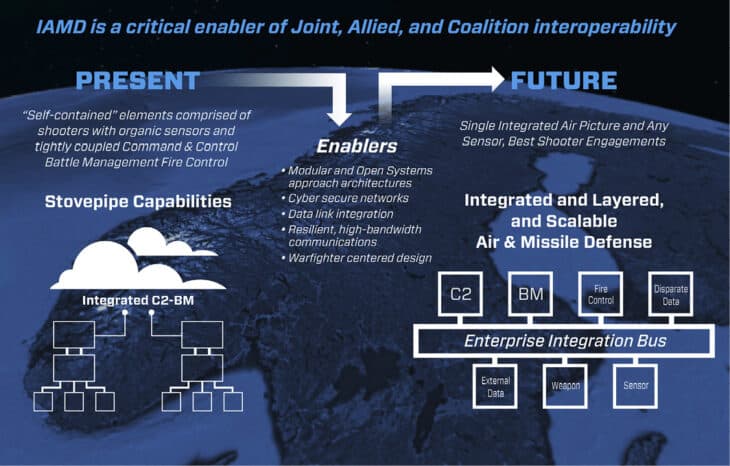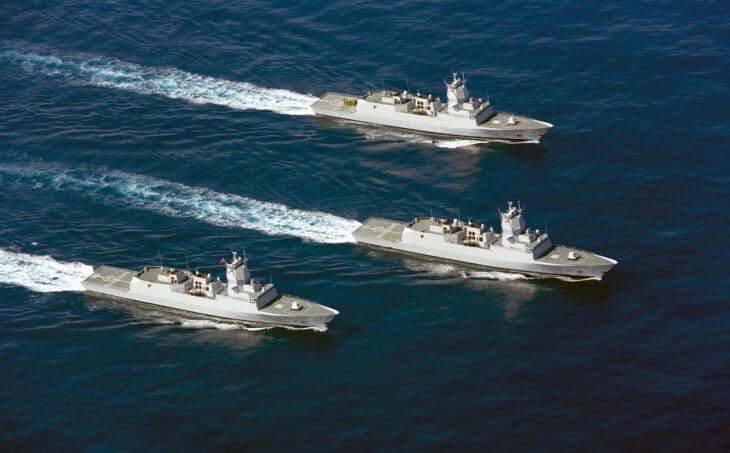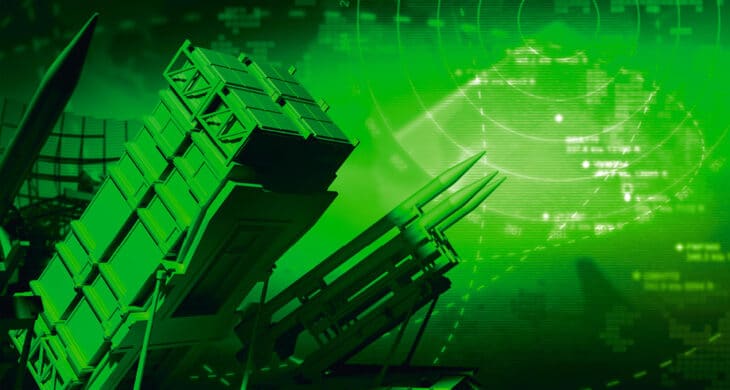Getting more out of the sum of the parts: harnessing today’s technology – To better integrate air and missile defense assets for norway
“We’d better be prepared to dominate the skies above the surface of the earth or be prepared to be buried beneath it.” General Carl A. “Tooey” Spaatz

As Norway grapples with and debates the merits of a national policy concerning missile defense, it is important for policy and military decision makers to consider not only if it will join in participation into a larger coalition missile defense arrangement, but also what kind of missile defense capability it wishes to employ. One such vision for Norway is one in which all capabilities – offensive, defensive, kinetic, non-kinetic, active and passive are melded into a comprehensive multi-domain capability preventing an adversary from effectively employing its air and missile weapons systems. This is the vision for future U.S. missile defense architecture, and it may be instructive to consider a similar path for Norway.
One thing is not up for debate: The threat from a ballistic missile and increasingly from a non-ballistic missile attack continues to grow. More and more, the air and integrated air and missile defense battlespace is becoming the most complex scene in any domain of battle.
The future missile defense environment will be characterized by a full spectrum of air-breathing and missile threats to include ballistic missiles, cruise missiles, aircraft, unmanned systems, long-range rockets, artillery, and mortars – all utilizing a range of advanced capabilities such as stealth technology, maneuvering vehicles, decoys, and precision targeting. This “renaissance of missile threats” has given rise to new problems for freedom loving nations around the world. What makes the issue even more complex is that adversary technologies are demonstrating more sophisticated and reliable missiles with increasing complexity, range and accuracy. The ability to develop a robust yet affordable missile defense will be challenging to say the least. This challenge is not unique to Norway of course, but is also something the United States and other NATO nations continue to study and debate.
The convergence of missile defense and integrated air and missile defense
For years, the conversation about missile defense in the U.S. has centered solely on detecting, tracking, and defeating incoming ballistic missiles. However, increasingly, the United States and Norway not only face the threat of ballistic threats but also conventional and low radar cross-section cruise missiles and other air-breathing threats. Defense planners and policy architects can no longer think about the range of the problem narrowly, but need to acknowledge that ballistic missile defense and defense from air breathing threats must be addressed with a holistic approach. Wars are not fought in stovepipes, yet capabilities have largely been developed in that way, ignoring thoughts on how to fold in other elements of the integrated air defense equation. Future development of integrated air and missile defense systems needs to demonstrate more commonality in sensors, shooters, and command and control. Norway will be required to respond to a range of threats—missile and air—and not just one domain or the other.
One thing is not up for debate: The threat from a ballistic missile and increasingly from a non-ballistic missile attack continues to grow. More and more, the air and integrated air and missile defense battlespace is becoming the most complex scene in any domain of battle
Historically, air and missile defense systems have been designed piecemeal without consideration for integration within a complete architecture. Decades-old development approaches resulted in tightly coupled weapon systems and sensors, closed systems, high engineering and sustainment costs, and lack of data sharing. These discrete closed systems have stymied attempts at true integration across a larger and more comprehensive defense solution. Additionally, technical challenges associated with creating a common, integrated air picture, coupled with an increasingly complex battlespace, have greatly increased the degree of muddle, increasing the risk of fratricide. And even more recently, concerns about the cyber threat have served to discourage efforts to integrate, and make interoperable, disparate systems owned by different nations. As a result, realizing the operational benefits that come from integrating the warfighting capabilities of joint, allied, and coalition forces has never fully been achieved. This problem of trying to integrate disparate systems after the fact has hampered U.S. efforts toward full multi-domain integration and lessoned the effectiveness of missile defense architectures. The growing and emerging threats demand we change our thinking in this regard.
Towards a more integrated air and missile defense: the promise of emerging C4I technology
The evolving threat necessitates an integrated missile defense approach, and modern technology means that doing so may be well within reach. By establishing common data links and protocols and leveraging advances in communications, computing power, networking, security, and software development, significant progress can be made toward integrating air and missile defenses to create a network of any sensor to any effector. The potential now exists, to create a single integrated air picture, shared at all levels -from national levels down to deployed ground based air defense teams at the forward edge of the battlefield. Furthermore, there exists the ability to provide for cyber protection measures so disparate systems from multi-national sources can be integrated to operate together safely and securely. This is the path being pursued by U.S. decision makers for the U.S. integrated air and missile defense architecture, and the merits of such an approach apply more broadly.
The graphic below depicts the critical components for integrating air and missile defenses to enable joint, allied, and coalition interoperability. These components encompass modular and opens systems approach (MOSA) architectures, cyber security, resilient communications, and operator-centric design. A MOSA-based architecture provides the capability to seamlessly integrate legacy weapon systems while providing a network systems architecture that is scalable and adaptable to facilitate the acquisition and integration of future weapons systems and sensors.
In a complex air and missile threat environment, this federated capability can integrate track data from various air defense sensors – for the Norway case, existing maritime, air, and ground based assets as well as new capabilities brought into the architecture, either now, or in the future – to create highly accurate threat tracks and a means to deal with them.
Wars are not fought in stovepipes, yet capabilities have largely been developed in that way, ignoring thoughts on how to fold in other elements of the integrated air defense equation
In addition to the provision of a common operating picture, assimilating digitized information from multiple, disparate sources provides a suite of battle management decision aids to facilitate effective planning and threat engagement. This synthesized picture would be published to a Command, Control, Communications, Computers, and Intelligence C4I network and optimally paired to an effector that is most suitable for defeating the specific target. Against a specific threat, such as a helicopter or cruise missile, various effectors could be effective, but at varying levels of probability of kill and with a potentially substantial difference in cost. An agile, flexible, cooperative, “any sensor, best shooter” capability, would be supported and enabled by a cybersecure, protected, tactical communications network capable of linking multiple domains.
Integrating multiple weapon systems and sensors onto a cooperative single C2 network would allow Norway to create a sovereign, fully integrated capability using existing and planned future assets. It would provide significant benefits through the incremental addition of assets over time, as opposed to the fielding of a “big bang” system all at once with limited opportunity for upgrading as the threat evolves. The benefits of this modular, net-centric, cyber-secure, MOSA-based system approach in overcoming the integration, modernization and affordability challenges of the past would be significant at the national level, and within a coalition environment. Effective from the tactical to the strategic levels, this capability would enhance the defense of Norway in a European threat scenario by including enabling enhanced integration with the US Ballistic Missile Defense System (BMDS) through existing networks. It would also provide enhanced protection of Norwegian forces on deployed operations, by seamlessly linking them into the air and missile defense systems of allied and friendly nations.
The advent of 5th generation systems adds another dimension to integrated air and missile defense capability. Their ability to operate in contested, information-centric operating environments and to leverage advanced sensor, data fusion and communications technologies will enable them to act as sensors, shooters, or communications platforms in contested battlespace. If the information they collect can be shared with other non-5th generation systems – and the technology currently exists to ensure that it can – the co-operative exploitation of their transformational ISR capabilities, including in relation to long range, early warning of threats, will further future modernization and digitization of the battlefield.
Capturing the benefits of an integrated approach
The potential benefits associated with leveraging modern C4I technologies to network existing capabilitied can be quantifies in the following ways:
(a) Greatly enhanced situational awareness derived from the integration and leveraging of data from disparate national and coalition sensors, tactical and strategic, on land, sea and in the air;
(b) High degrees of mutual confidence that this integrated picture is generated and shared within an appropriately cyber-protected environment;
(c) Decision superiority consequent on commanders at the right level being able to draw in more timely fashion on clearer, more complete information;
(d) Kill chain optimisation in terms of the speed and quality of weapon/target allocation and the utilisation of best-placed assets;
(e) Lower risk of fratricide through the provision of a shared, common operating picture;
(f) Reduced overall cost by the more effective and efficient utilisation of existing and planned assets, including the incremental addition of new assets via MOSA integration;
(g) Any sensor to best effector, improving military efficiency with available magazine through the integration of any sensor and the issuance of fire control quality orders to any effector
(h) Incremental System Development, through the ability to tie any sensor to any effector provides flexibility as soon as they are tied in. By breaking apart traditional stovepipes, acquiring sensors and effectors and C2 simultaneously is not necessary, but rather can be added incrementally. This included leveraging legacy/existing sensors and effectors.
Making a Real Commitment to Passive Defense Measures
One final and often overlooked part of the equation is passive defense. Regardless of how it decides to proceed, Norway can and should consider its passive missile defense capabilities for the future. Passive missile defense measures are genuine force multipliers and must not be neglected. Passive defense measures such as denial, deception, mobility, hardening, and information operations, coupled with active defensive and offensive operations, are force multipliers assuring mission success. Failure to fully integrate and coordinate offensive, active, and passive actions places Joint Force objectives and resources at unnecessary risk.
The planning required to take optimize passive missile defense measures must occur before fielding and employment of missile defense and integrated air and missile defense systems takes place. In order to take maximum economic advantage of the values of these measures, requirements makers, materiel developers, and industry partners must work together more closely with end users to determine how best to take advantage of these opportunities. Any consideration for how Norway proceeds should explicitly consider passive defense measures as a mandatory part of the entire equation.
Conclusion:
Regardless of how it proceeds, Norway should be mindful of the lessons learned in the United States about how to, and how not to, design and develop its missile defense capabilities. Should as nation Norway decide to continue down the path toward developing its national capability, it should be ever mindful to do so in a holistic and coordinated way, linking and integrating its capabilities in all domains together, rather than doing so piecemeal and in a vacuum. The power and potential of networked integration is simply too great to ignore. More importantly, the growing nature of an ever-more sophisticated threat will demand nothing less in order to ensure success.
About the autor:
Brigadier General Kenneth Todorov, USAF (Ret), is the former Deputy Director at the U.S. Missile Defense Agency and former Director of the Joint Integrated Air and Missile Defense Organization in the Pentagon. He is currently a non-resident expert at the Missile Defense Project at the Center for Strategic and International Studies (CSIS) in Washington, D.C.





